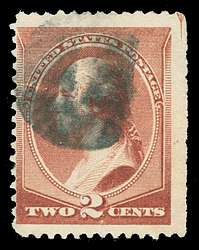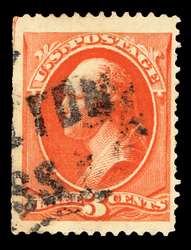| Guideline And Straight Edge Positions -- Early Issues |
| Scott # |
|
Mint Hinged US$ |
Used US$ |
||
| 244573 |
Scott #112 [1869 1c buff Franklin] Used with F-VF centering and bold segmented carved cancellation. Natural sheet margin straight edge at left. Huge margins on left and bottom, completely clear at top and right. I think collecting the possible natural sheet-margin straight-edge positions would be an interesting and challenging endeavor. (Scott 2022 $140.)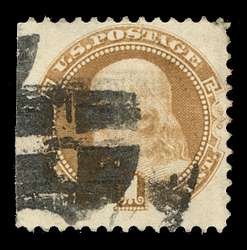 ACTUAL item. |
--- |
84.00 |
||
| 244761 |
Scott #113 [1869 2c brown Post Rider] Mint with F-VF+ centering, full original gum with reasonable hinge remnant. This example has a wide natural straight edge on the right side. Such straight edges were originally scarcer (the left and right were either each only 10% or 15% of the original issue quantity), however, it seems that the majority of them have long since been reperforated to make them look like perforated-4-side stamps. I think collecting the natural straight edges of the 1c-12c values of the 1869 issue would be a fun and challenging endeavor! Mint examples especially are now scarce with natural straight edges. Deep, rich color, with very clean and clear engraving impression with an unusual amount of detail -- a proof-like impression! (Scott 2022 $500.)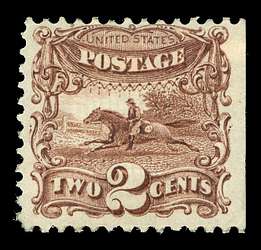 ACTUAL item. |
425.00 |
--- | ||
| 253009 |
Scott #115 [1869 6c ultramarine Washington] Used with Average centering resulting in a "straddle" example showing part of the adjacent stamp. An extraordinary example with jumbo side margins showing the straight-edge sheet margin at left -- such positions are remarkably hard to find these days. Very fresh appearance with brilliant color and excellent perforations. An eye-catching accent piece! (Scott 2025 $225.)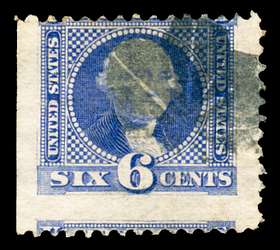 ACTUAL item. |
--- |
79.00 |
||
| 248533 |
Scott #135 [1870 2c brown Jackson, National, H Grill] Used with Fine centering, but with a couple short perfs on the left side. and a "blob" cancellation. The impression of the grill is quite clear. #135 Right margin example, with wide natural straight edge on right. Printed in sheets of 200 and divided into two side-by-side panes of 100 (10 x 10) by cutting, resulting in natural straight edges. There is an arrow in the top and bottom margin that is very close to the top or bottom of the stamp design, thus at least the tip of the arrow is usually visible on stamps in those positions. A tiny vertical guideline extends only 2 mm from the tip of the arrow. Examples with a large portion of the arrow are more unusual and in high demand. There are SHEET margins at left and right, resulting in PANE margins at left OR right, the other side of the pane being a straight-edge. Only a maximum of four stamps, and usually only two stamps, out of each 200-stamp printer SHEET can show the arrow position. Only 20 stamps out of every 200-stamp printer SHEET had the natural straight edge; 10 on the right side of the left 100-stamp PANE and 10 on the left side of the right 100-stamp PANE. Examples with the straight edge on right or left are now hard to find (most were used for postage rather than going into collections; and of those that remained, in the last 50 years many -- at least of Mint stamps -- have been reperforated to remove the straight edge). In the case of Used stamps with straight edges of this otherwise-inexpensive issue, many (most?) were discarded by collectors before their relative scarcity was understood. I think that collecting the guideline and straight-edge positions is quite challenging and rewarding. (Scott 2024 $85, for a normal plate position.)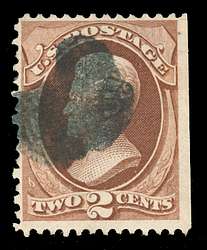 ACTUAL item. |
--- |
24.00 |
||
| 248528 |
Scott #136 [1870 3c green Washington, H Grill] Used with Fine centering, with three very large margins. The carved cancellation is in reverse and appears to the a "10" (with Roman "1"). Clear grill impression. Left margin example, with wide natural straight edge on left. Printed in sheets of 200 and divided into two side-by-side panes of 100 (10 x 10) by cutting, resulting in natural straight edges. There is an arrow in the top and bottom margin that is very close to the top or bottom of the stamp design, thus at least the tip of the arrow is usually visible on stamps in those positions. A tiny vertical guideline extends only 2 mm from the tip of the arrow. Examples with a large portion of the arrow are more unusual and in high demand. There are SHEET margins at left and right, resulting in PANE margins at left OR right, the other side of the pane being a straight-edge. Only a maximum of four stamps, and usually only two stamps, out of each 200-stamp printer SHEET can show the arrow position. Only 20 stamps out of every 200-stamp printer SHEET had the natural straight edge; 10 on the right side of the left 100-stamp PANE and 10 on the left side of the right 100-stamp PANE. Examples with the straight edge on right or left are now hard to find (most were used for postage rather than going into collections; and of those that remained, in the last 50 years many -- at least of Mint stamps -- have been reperforated to remove the straight edge). In the case of Used stamps with straight edges of this otherwise-inexpensive issue, many (most?) were discarded by collectors before their relative scarcity was understood. I think that collecting the guideline and straight-edge positions is quite challenging and rewarding. A handsome example of a stamp that can be hard to find in nice quality. (Scott 2024 $35.00 for normal plate position.) ACTUAL item. |
--- |
32.00 |
||
| 245823 |
Scott #156 Bright Ultramarine [1873 1c ultramarine-blue shades Franklin, Continental with Secret Mark, Thinner/Harder Paper] Used with Average centering. The postmark appears to be BROWN COLOR (Scott value +$20 if brown). Bright color and fresh appearance, with light, face-free cancellation. Natural left straight edge. This is left-margin stamp of the right pane. The Continental issues were printed in a sheet of 200 divided by cutting into two panes (left and right). I think that collecting straight-edge and arrow positions of this issue is quite challenging and rewarding.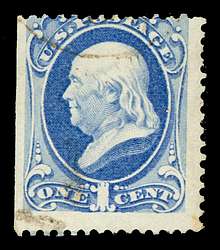 ACTUAL item. |
--- |
24.00 |
||
| 245876 |
Scott #165 Gray Black [1873 (1874) 30c gray black Alexander Hamilton, Continental Banknote printing] Used with VF centering with neat vertical barred oval numeric (16) cancellation. Natural right straight edge with just a couple "microscopic" tears in that right margin (typical). This is right-margin stamp of the left pane. The Continental issues were printed in a sheet of 200 divided by cutting into two panes (left and right). I think that collecting straight-edge and arrow positions of this issue is quite challenging and rewarding. Great centering, great color, great overall appearance. No other defects of any other kind. Seldom seen so nice, even though reperforated. (Scott 2022 Gray Black value $140, without taking into account that only 10% of the stamps printed had this right straight edge feature.)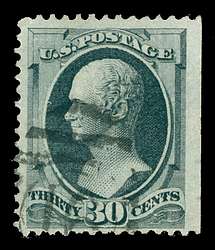 ACTUAL item. |
--- |
119.00 |
||
| 247620 |
Scott #205 [1882 5c brown James A. Garfield] This is the Scott-listed "yellow brown" color of this stamp. Used with Average centering and extremely light cancellation (the previous collector had thought the stamp was "Mint without gum"). Right margin example, with natural straight edge on right, from the top row of the left sheet, with full arrow showing at top left corner. The "only Average" centering is necessary for this example to so nicely show the arrow! Printed in sheets of 200 and divided into two side-by-side panes of 100 (10 x 10) by cutting, resulting in natural straight edges. There is an arrow in the top and bottom margin that is very close to the top or bottom of the stamp design, thus at least the tip of the arrow is usually visible on stamps in those positions. A tiny vertical guideline extends only 2 mm from the tip of the arrow. Examples with a large portion of the arrow are more unusual and in high demand. There are SHEET margins at left and right, resulting in PANE margins at left OR right, the other side of the pane being a straight-edge. Only a maximum of four stamps, and usually only two stamps, out of each 200-stamp printer SHEET can show PARTS of the arrow position. However, a maximum of one stamp out of 200 can show the complete respective (top or bottom) arrow; usually NO stamps out of 200 show the complete arrow. Only 20 stamps out of every 200-stamp printer SHEET had the natural straight edge; 10 on the right side of the left 100-stamp PANE and 10 on the left side of the right 100-stamp PANE. Examples with the straight edge on right or left are now hard to find (most were used for postage rather than going into collections; and of those that remained, in the last 50 years many -- at least of Mint stamps -- have been reperforated to remove the straight edge). In the case of Used stamps with straight edges of this otherwise-inexpensive issue, many (most?) were discarded by collectors before their relative scarcity was understood. I think that collecting the guideline and straight-edge positions is quite challenging and rewarding. Philatelic trivia: This memorial stamp was intended to be issued in black, as was the Lincoln memorial stamp, but when the design was shown to Mrs. Garfield, she rejected the black color in favor of brown. A very interesting example, showing the top arrow about as complete as is possible on a single stamp.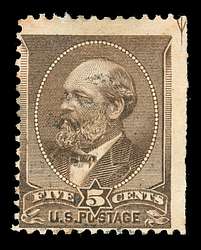 ACTUAL item. |
--- |
25.00 |
||
| 265522 |
Scott #207 [1881 3c blue green Washington] HORIZONTAL PAIR, Mint with F-VF centering. This is "never hinged" but with gum disturbances so priced as hinged. There is a small toned spot in the central margin, the right stamp has a tiny inclusion speck in the top margin, and there is very slight gum creasing. The left stamp of the pair is a left margin example, with natural straight edge on left, from the left column of the right sheet. Printed in sheets of 200 and divided into two side-by-side panes of 100 (10 x 10) by cutting, resulting in natural straight edges. There is an arrow in the top and bottom margin (both in most or all Scott #134-218 issues), that is very close to the top or bottom of the stamp design, thus at least the tip of the arrow is usually visible on stamps in those positions. A tiny vertical guideline extends only 2 mm from the tip of the arrow. Examples with a large portion of the arrow are more unusual and in high demand. There are SHEET margins at left and right, resulting in PANE margins at left OR right, the other side of the pane being a straight-edge. Only a maximum of four stamps, and usually only two stamps, out of each 200-stamp printer SHEET can show the arrow position. Only 20 stamps out of every 200-stamp printer SHEET had the natural straight edge; 10 on the right side of the left 100-stamp PANE and 10 on the left side of the right 100-stamp PANE. Examples with the straight edge on right or left are now hard to find (most were used for postage rather than going into collections; and of those that remained, in the last 50 years many -- at least of Mint stamps -- have been reperforated to remove the straight edge). In the case of Used stamps with straight edges of this often-inexpensive time period, many (most?) were discarded by collectors before their relative scarcity was understood. I think that collecting the guideline and straight-edge positions is quite challenging and rewarding. Despite the faults, this is an attractive and unusual 19th Century multiple and position piece. (Scott 2025 value $180 for a Mint Hinged pair.)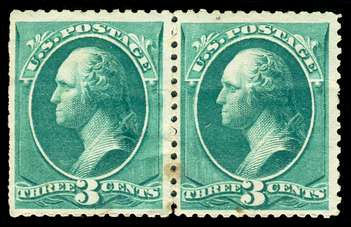 ACTUAL item. |
29.00 |
--- | ||
| 243187 |
Scott #210 [1883 2c Red Brown Washington] Mint, lightly hinged, with Fine centering. Left margin example, from top row of sheet WITH ARROW AT TOP LEFT, with natural straight edge on left, from the left column of the right sheet. Printed in sheets of 200 and divided into two side-by-side panes of 100 (10 x 10) by cutting, resulting in natural straight edges. There is an arrow in the top and bottom margin that is very close to the top or bottom of the stamp design, thus at least the tip of the arrow is usually visible on stamps in those positions. A tiny vertical guideline extends only 2 mm from the tip of the arrow. Examples with a large portion of the arrow are more unusual and in high demand. There are SHEET margins at left and right, resulting in PANE margins at left OR right, the other side of the pane being a straight-edge. Only a maximum of four stamps, and usually only two stamps, out of each 200-stamp printer SHEET can show the arrow position. Only 20 stamps out of every 200-stamp printer SHEET had the natural straight edge; 10 on the right side of the left 100-stamp PANE and 10 on the left side of the right 100-stamp PANE. Examples with the straight edge on right or left are now hard to find (most were used for postage rather than going into collections; and of those that remained, in the last 50 years many -- at least of Mint stamps -- have been reperforated to remove the straight edge). In the case of Used stamps with straight edges of this often-inexpensive time period, many (most?) were discarded by collectors before their relative scarcity was understood. I think that collecting the guideline and straight-edge positions is quite challenging and rewarding. Very fresh and attractive. (Scott 2025 $45.00 for normal example.) ACTUAL item. |
37.00 |
--- |

